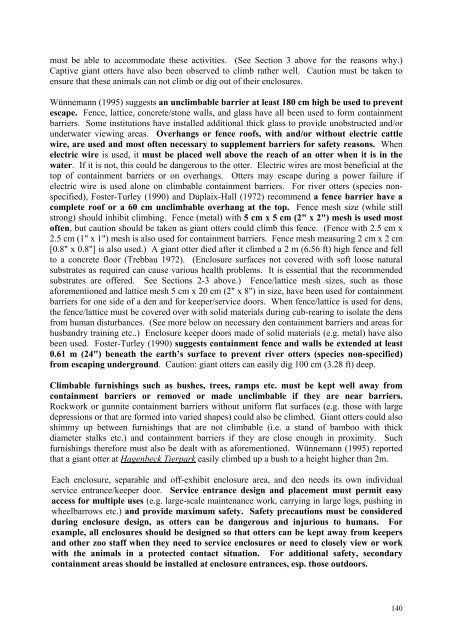International Giant Otter Studbook Husbandry and Management
International Giant Otter Studbook Husbandry and Management
International Giant Otter Studbook Husbandry and Management
You also want an ePaper? Increase the reach of your titles
YUMPU automatically turns print PDFs into web optimized ePapers that Google loves.
must be able to accommodate these activities. (See Section 3 above for the reasons why.)<br />
Captive giant otters have also been observed to climb rather well. Caution must be taken to<br />
ensure that these animals can not climb or dig out of their enclosures.<br />
Wünnemann (1995) suggests an unclimbable barrier at least 180 cm high be used to prevent<br />
escape. Fence, lattice, concrete/stone walls, <strong>and</strong> glass have all been used to form containment<br />
barriers. Some institutions have installed additional thick glass to provide unobstructed <strong>and</strong>/or<br />
underwater viewing areas. Overhangs or fence roofs, with <strong>and</strong>/or without electric cattle<br />
wire, are used <strong>and</strong> most often necessary to supplement barriers for safety reasons. When<br />
electric wire is used, it must be placed well above the reach of an otter when it is in the<br />
water. If it is not, this could be dangerous to the otter. Electric wires are most beneficial at the<br />
top of containment barriers or on overhangs. <strong>Otter</strong>s may escape during a power failure if<br />
electric wire is used alone on climbable containment barriers. For river otters (species nonspecified),<br />
Foster-Turley (1990) <strong>and</strong> Duplaix-Hall (1972) recommend a fence barrier have a<br />
complete roof or a 60 cm unclimbable overhang at the top. Fence mesh size (while still<br />
strong) should inhibit climbing. Fence (metal) with 5 cm x 5 cm (2" x 2") mesh is used most<br />
often, but caution should be taken as giant otters could climb this fence. (Fence with 2.5 cm x<br />
2.5 cm (1" x 1") mesh is also used for containment barriers. Fence mesh measuring 2 cm x 2 cm<br />
[0.8" x 0.8"] is also used.) A giant otter died after it climbed a 2 m (6.56 ft) high fence <strong>and</strong> fell<br />
to a concrete floor (Trebbau 1972). (Enclosure surfaces not covered with soft loose natural<br />
substrates as required can cause various health problems. It is essential that the recommended<br />
substrates are offered. See Sections 2-3 above.) Fence/lattice mesh sizes, such as those<br />
aforementioned <strong>and</strong> lattice mesh 5 cm x 20 cm (2" x 8") in size, have been used for containment<br />
barriers for one side of a den <strong>and</strong> for keeper/service doors. When fence/lattice is used for dens,<br />
the fence/lattice must be covered over with solid materials during cub-rearing to isolate the dens<br />
from human disturbances. (See more below on necessary den containment barriers <strong>and</strong> areas for<br />
husb<strong>and</strong>ry training etc..) Enclosure keeper doors made of solid materials (e.g. metal) have also<br />
been used. Foster-Turley (1990) suggests containment fence <strong>and</strong> walls be extended at least<br />
0.61 m (24") beneath the earth’s surface to prevent river otters (species non-specified)<br />
from escaping underground. Caution: giant otters can easily dig 100 cm (3.28 ft) deep.<br />
Climbable furnishings such as bushes, trees, ramps etc. must be kept well away from<br />
containment barriers or removed or made unclimbable if they are near barriers.<br />
Rockwork or gunnite containment barriers without uniform flat surfaces (e.g. those with large<br />
depressions or that are formed into varied shapes) could also be climbed. <strong>Giant</strong> otters could also<br />
shimmy up between furnishings that are not climbable (i.e. a st<strong>and</strong> of bamboo with thick<br />
diameter stalks etc.) <strong>and</strong> containment barriers if they are close enough in proximity. Such<br />
furnishings therefore must also be dealt with as aforementioned. Wünnemann (1995) reported<br />
that a giant otter at Hagenbeck Tierpark easily climbed up a bush to a height higher than 2m.<br />
Each enclosure, separable <strong>and</strong> off-exhibit enclosure area, <strong>and</strong> den needs its own individual<br />
service entrance/keeper door. Service entrance design <strong>and</strong> placement must permit easy<br />
access for multiple uses (e.g. large-scale maintenance work, carrying in large logs, pushing in<br />
wheelbarrows etc.) <strong>and</strong> provide maximum safety. Safety precautions must be considered<br />
during enclosure design, as otters can be dangerous <strong>and</strong> injurious to humans. For<br />
example, all enclosures should be designed so that otters can be kept away from keepers<br />
<strong>and</strong> other zoo staff when they need to service enclosures or need to closely view or work<br />
with the animals in a protected contact situation. For additional safety, secondary<br />
containment areas should be installed at enclosure entrances, esp. those outdoors.<br />
140

















